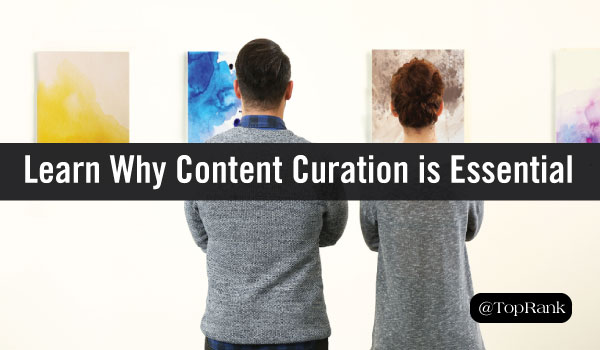
Imagine if an art museum contained every single painting created over a hundred-year period. It wouldn’t be much fun to visit, right? Hundreds of thousands of images, of wildly varying quality, without organization or context? It would be like a Google image search crossed with a garage sale.
Content curation is what turns a warehouse full of art and artifacts into a museum. A good curator sifts through the content to find pieces that are valuable for an intended audience. Their job is to direct attention to worthy content—and in doing so, make the museum a worthwhile place to visit.
Your blog readers and social media followers are drowning in content. You can be the content curator that helps direct their attention to what is most helpful, educational, or entertaining. Content curation, as part of your editorial strategy, can help make your blog a more valuable destination for your readers.
But the benefits go both ways; as you help your readers find great content, you’re helping your organization, too. Here are just a few ways curated content can help advance your marketing goals, and some of our favorite curating tools.
The Benefits of Content Curation
#1: Fill Your Editorial Calendar
It takes consistent publishing of quality content to make your blog a destination for readers. TKeeping up a regular cadence can be tricky, especially with a small (or non-existent) content team. Curation helps fill in the blanks with less effort than it takes to create new content.
#2: Provide Variety from Promotional Content
One of the top reasons people unfollow brands on social media is too much promotional content. Even if your content genuinely adds value beyond promoting the brand, people can get burned out on your brand’s voice. Pulling in content from other sources gives readers variety without pushing them off your site.
#3: Enhance Your Brand’s Credibility
Your brand content should have a definite point of view, taking a strong stance on issues that affect your industry. That’s a vital part of developing thought leadership. But don’t go it alone; curate supporting content from other respected industry players. Add context to this third-party support to show how it matches your brand’s philosophy, and you can boost your credibility.
#4: Expand Your Audience
Curation not only helps you better serve your existing audience, it can help you reach a new set of relevant readers. Share your curated post on social media and tag your sources, and they’re likely to share the post with their audience as well.
#5: Spark Influencer Relationships
When you’re seeking to engage an influencer, it helps to give before you ask. Start by following your influencers on social media, then include some of their existing content (properly quoted and credited) in your curated post. Then when you make initial contact, you can show that you’re already promoting them. Many of our most valuable long-term influencer relationships started with a curated post.
Content Curation Tools:
#1: Buzzsumo
Buzzsumo finds most-shared content based on a keyword, topic, or even a domain. It’s my go-to tool for weekly or monthly roundups. The “trending now” feature is fantastic for surfacing content that’s just starting to gain traction, so you can share it before it goes viral. There’s a free version with limited functionality, but I’ve found the paid version is well worth the investment.
#2: Feedly
Feedly is a great way to keep up with multiple content streams, to find the pieces that will be most valuable to your audience. You can customize it with RSS feeds from your favorite sites and see everything in one place. Replace your daily content crawl with a single organized list.
#3: Pocket
Pocket makes it possible to curate content wherever you are, from your morning commute to your late-night Facebook crawl. It’s especially useful for saving content when you see a promising headline, but don’t have time to peruse the article. Essentially you can fill your Pocket throughout the day, then evaluate what you’ve saved and choose what to use.
#4: Twitter Lists
If you follow more than a few people on Twitter, odds are your main feed is a quick-scrolling, impossible-to-follow mess. Twitter lists can help organize the information into something actually useful. Create a list of accounts that regularly tweet curation-worthy content, and it can be a valuable resource.
#5: Industry Newsletters
Email marketing is in something of a creative renaissance right now. As a marketer, it’s a great tactic for reaching your audience. As a curator, though, you should check out email newsletters from the audience side. Sign up for newsletters from your colleagues in the industry—perhaps even competitors—to find more content you can share with your audience.
Help Your Audience Find the Good Stuff
Content curation is good for your audience—it helps cut through content clutter so they can focus on the good stuff. And, of course, what’s good for your audience is good for your business. Add curation to your content strategy to provide value for your audience, expand that audience, and lay the groundwork for influencer co-created content in the future.
For more influencer marketing tips, check out our research guide Influence 2.0: The Future of Influencer Marketing.


